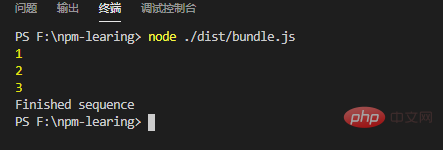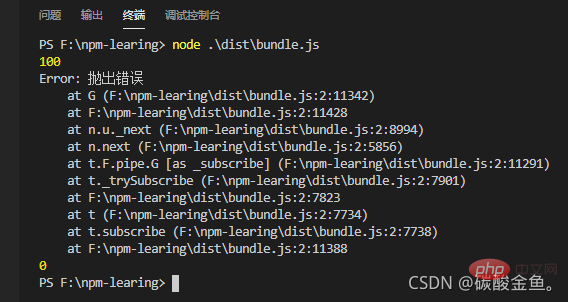 Web Front-end
Web Front-end
 JS Tutorial
JS Tutorial
 A brief analysis of observable objects, observers and RxJS operators in Angular
A brief analysis of observable objects, observers and RxJS operators in Angular
A brief analysis of observable objects, observers and RxJS operators in Angular
This article will introduce you to the observable objects (Observable), observers (observer) and RxJS operators in Angular. I hope it will be helpful to everyone!

Observable (observable object)
Observable (observable object) is inside the RxJS library An object that can be used to handle asynchronous events, such as HTTP requests (in fact, in Angular, all HTTP requests return Observable). [Recommended tutorials: "angular tutorial"]
Perhaps, you have come into contact with something called promise before. They are essentially the same: they are all produced The operator actively "push" products to consumers, while consumers passively receive them, but there is still a big difference between them: Observable can send any number of values, and, after being subscribed Before, it would not execute ! This is a feature that promise does not have.
-
Observableis used to transmit messages between the sender and the receiver. You can regard these messages as streams - When creating
Observableobject, you need to pass in a function as a parameter of the constructor. This function is called Subscriber function . This function is where the producer pushes messages to the consumer. - Before being
subscribe(subscribed) by the consumer, the subscriber function will not be executed until thesubscribe()function is called, which returns asubscriptionobject, There is aunsubscribe()function inside, and consumers can refuse to receive messages at any time! -
subscribe()The function receives anobserver(observer)object as an input parameter - The sending of the message can be synchronous or Asynchronous
observer (observer)
With an observable object (sender) , you need an observer (receiver) To observe observable objects, the observer must implement the observer interface, which is an object containing three properties, all of which are functions, as follows:
| Notification Type | Description |
|---|---|
| Required. Use the received value as input parameter and execute under normal circumstances. May be executed zero or more times. | |
| Optional. Executed in case of error. Errors interrupt the execution of this observable object instance. | |
| Optional. Executed when the transfer is completed. |
The above is the detailed content of A brief analysis of observable objects, observers and RxJS operators in Angular. For more information, please follow other related articles on the PHP Chinese website!

Hot AI Tools

Undresser.AI Undress
AI-powered app for creating realistic nude photos

AI Clothes Remover
Online AI tool for removing clothes from photos.

Undress AI Tool
Undress images for free

Clothoff.io
AI clothes remover

AI Hentai Generator
Generate AI Hentai for free.

Hot Article

Hot Tools

Notepad++7.3.1
Easy-to-use and free code editor

SublimeText3 Chinese version
Chinese version, very easy to use

Zend Studio 13.0.1
Powerful PHP integrated development environment

Dreamweaver CS6
Visual web development tools

SublimeText3 Mac version
God-level code editing software (SublimeText3)

Hot Topics
 Let's talk about metadata and decorators in Angular
Feb 28, 2022 am 11:10 AM
Let's talk about metadata and decorators in Angular
Feb 28, 2022 am 11:10 AM
This article continues the learning of Angular, takes you to understand the metadata and decorators in Angular, and briefly understands their usage. I hope it will be helpful to everyone!
 How to install Angular on Ubuntu 24.04
Mar 23, 2024 pm 12:20 PM
How to install Angular on Ubuntu 24.04
Mar 23, 2024 pm 12:20 PM
Angular.js is a freely accessible JavaScript platform for creating dynamic applications. It allows you to express various aspects of your application quickly and clearly by extending the syntax of HTML as a template language. Angular.js provides a range of tools to help you write, update and test your code. Additionally, it provides many features such as routing and form management. This guide will discuss how to install Angular on Ubuntu24. First, you need to install Node.js. Node.js is a JavaScript running environment based on the ChromeV8 engine that allows you to run JavaScript code on the server side. To be in Ub
 Detailed explanation of angular learning state manager NgRx
May 25, 2022 am 11:01 AM
Detailed explanation of angular learning state manager NgRx
May 25, 2022 am 11:01 AM
This article will give you an in-depth understanding of Angular's state manager NgRx and introduce how to use NgRx. I hope it will be helpful to you!
 A brief analysis of how to use monaco-editor in angular
Oct 17, 2022 pm 08:04 PM
A brief analysis of how to use monaco-editor in angular
Oct 17, 2022 pm 08:04 PM
How to use monaco-editor in angular? The following article records the use of monaco-editor in angular that was used in a recent business. I hope it will be helpful to everyone!
 How to use Vue.observable to create observable objects in Vue
Jun 11, 2023 am 10:45 AM
How to use Vue.observable to create observable objects in Vue
Jun 11, 2023 am 10:45 AM
Vue is a popular JavaScript framework that provides many features, including observable objects. An Observable is a reactive object that notifies all components and properties that depend on it when it changes. Vue.observable is a function used to create observable objects. This article will introduce the implementation method and common scenarios of Vue.observable. 1. Basic usage of Vue.observable First, use Vue.ob in Vue
 An article exploring server-side rendering (SSR) in Angular
Dec 27, 2022 pm 07:24 PM
An article exploring server-side rendering (SSR) in Angular
Dec 27, 2022 pm 07:24 PM
Do you know Angular Universal? It can help the website provide better SEO support!
 Angular + NG-ZORRO quickly develop a backend system
Apr 21, 2022 am 10:45 AM
Angular + NG-ZORRO quickly develop a backend system
Apr 21, 2022 am 10:45 AM
This article will share with you an Angular practical experience and learn how to quickly develop a backend system using angualr combined with ng-zorro. I hope it will be helpful to everyone!
 What should I do if the project is too big? How to split Angular projects reasonably?
Jul 26, 2022 pm 07:18 PM
What should I do if the project is too big? How to split Angular projects reasonably?
Jul 26, 2022 pm 07:18 PM
The Angular project is too large, how to split it reasonably? The following article will introduce to you how to reasonably split Angular projects. I hope it will be helpful to you!








